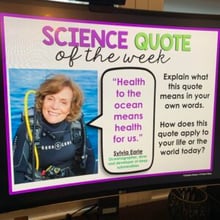Potential and Kinetic Energy Activities
for Middle School Science
The resources below will provide students a comprehensive understanding of potential and kinetic energy. All of the following lessons are also included in the Kesler Science Membership.
The Potential and Kinetic Energy 5E Lesson includes materials for every "E" phase, including the Potential and Kinetic Energy Station Lab for Exploration and an interactive PowerPoint with digital INB templates for Explanation.
The lesson also includes introduction materials for Engagement, student-choice project ideas for Elaboration, and assessments for Evaluation.
After completing the Potential and Kinetic Energy 5E Lesson, students will be able to compare and contrast potential and kinetic energy, including real-world situations of each type of energy.
The Potential and Kinetic Energy Inquiry Lab is a hands-on activity that is differentiated for advanced, on-level, and modified middle school students.
Students will be introduced to the types of kinetic and potential energies and asked to identify which are present in a photograph.
The Potential and Kinetic Energy Inquiry Lab includes a brief reading passage, comprehension checks, hands-on activities, reflection questions, and a CER conclusion.
The Potential and Kinetic Energy Sub Plan is a complete lesson that takes students through a warm-up, reading passage, independent activity, extension activities, and an assessment.
The worksheets are designed to make your sub day a breeze for you, your students, and the substitute teacher. They are also perfect for distance learning.
Potential and Kinetic Energy Classroom Experiences
Create a powerful student experience to help solidify students' understanding about potential and kinetic energy. All of the following experiences are also included in the Kesler Science Membership.
Escape Rooms
The Potential and Kinetic Energy Escape Room is an immersive experience for your students. It allows them to demonstrate their knowledge of kinetic energy and potential energy in a fun and engaging way.
Students must use what they have learned to compare and contrast potential and kinetic energy. They will construct and interpret graphical displays of data to describe the relationships of kinetic energy to the mass of an object and to the speed of an object and develop a model to describe that when the arrangement of objects interacting at a distance changes, different amounts of potential energy are stored in the system. They must also be able to construct, use, and present arguments to support the claim that when the kinetic energy of an object changes, energy is transferred to or from the object to complete the escape room.
STEM CHALLENGES
The Project, Uncharted Waters - Build a Water Wheel for Energy STEM Challenge uses the engineering design process to create a prototype of a water wheel for a local farmer in your region. He will use the power it generates to light his barn.
Students will be using collaborative skills such as brainstorming with their peers and reflecting on their progress during the project.
At the end of the Project, Uncharted Waters - Build a Water Wheel for Energy, STEM challenge, students are given an opportunity to share their projects outside of the classroom.
Year-Round Resources
These year-round activities will increase your students' understanding of many middle school science topics. All of these activities are also included in the Kesler Science Membership.
Visual Data & Graphing
You're not alone if your students struggle with understanding graphs, charts, and tables. It's a skill that takes an enormous amount of practice. This resource will help students build a strong foundation in analyzing data and creating their own data visualizations.
Bell Ringers and Warm-Ups
These middle school science bell ringers are an excellent way to engage your students as soon as they walk into your classroom. This comprehensive FULL YEAR resource includes everything you need to start off each science class with an interesting warm-up activity.
Review Board Games
Each game board has been carefully designed to keep students engaged. There are 10 different action spaces on each board and dozens of question cards. All of the actions are related to science concepts and keep the students motivated throughout the game.
Each game is ready to play. Simply print out the board and the cards and let the students enjoy reviewing nine different units.
Essential Questions and Standards
Below are the essential questions and standards associated with the lessons and activities included in the potential and kinetic energy unit. This topic is only one of more than 100 middle school science topics included in the Kesler Science Membership.
-
How can you compare and contrast potential and kinetic energy?
-
MS PS3-1 - Construct and interpret graphical displays of data to describe the relationships of kinetic energy to the mass of an object and to the speed of an object
-
MS PS3-5 - Construct, use, and present arguments to support the claim that when the kinetic energy of an object changes, energy is transferred to or from the object
-
TEKS Science 6.8 A - Compare and contrast potential and kinetic energy
Kesler Science Membership
Imagine never having to search for another middle school science lesson again. The membership gives you access to ALL of the Kesler Science products in one place (Yes, including everything above).
Say goodbye to long hours of lesson prep.



